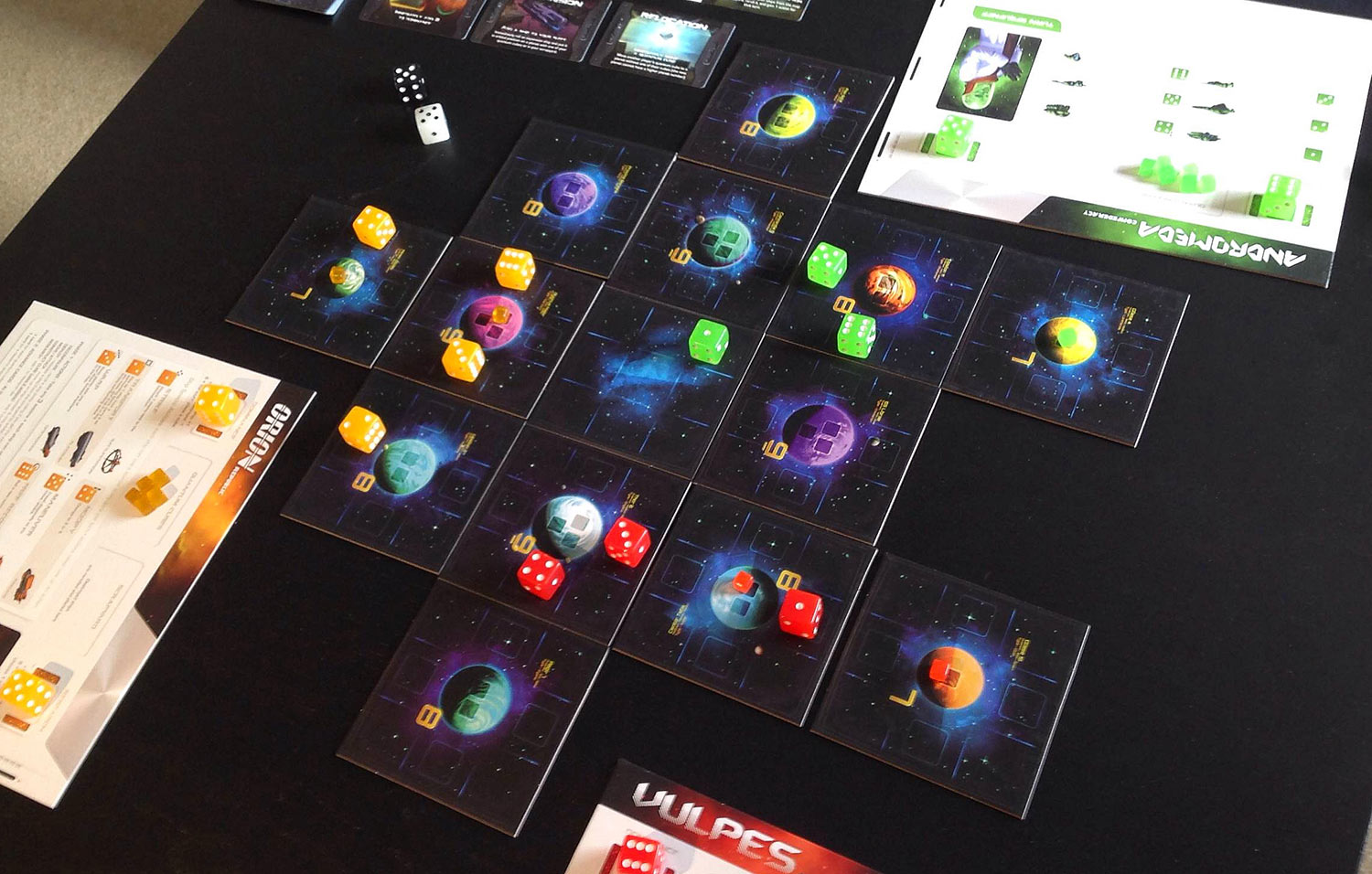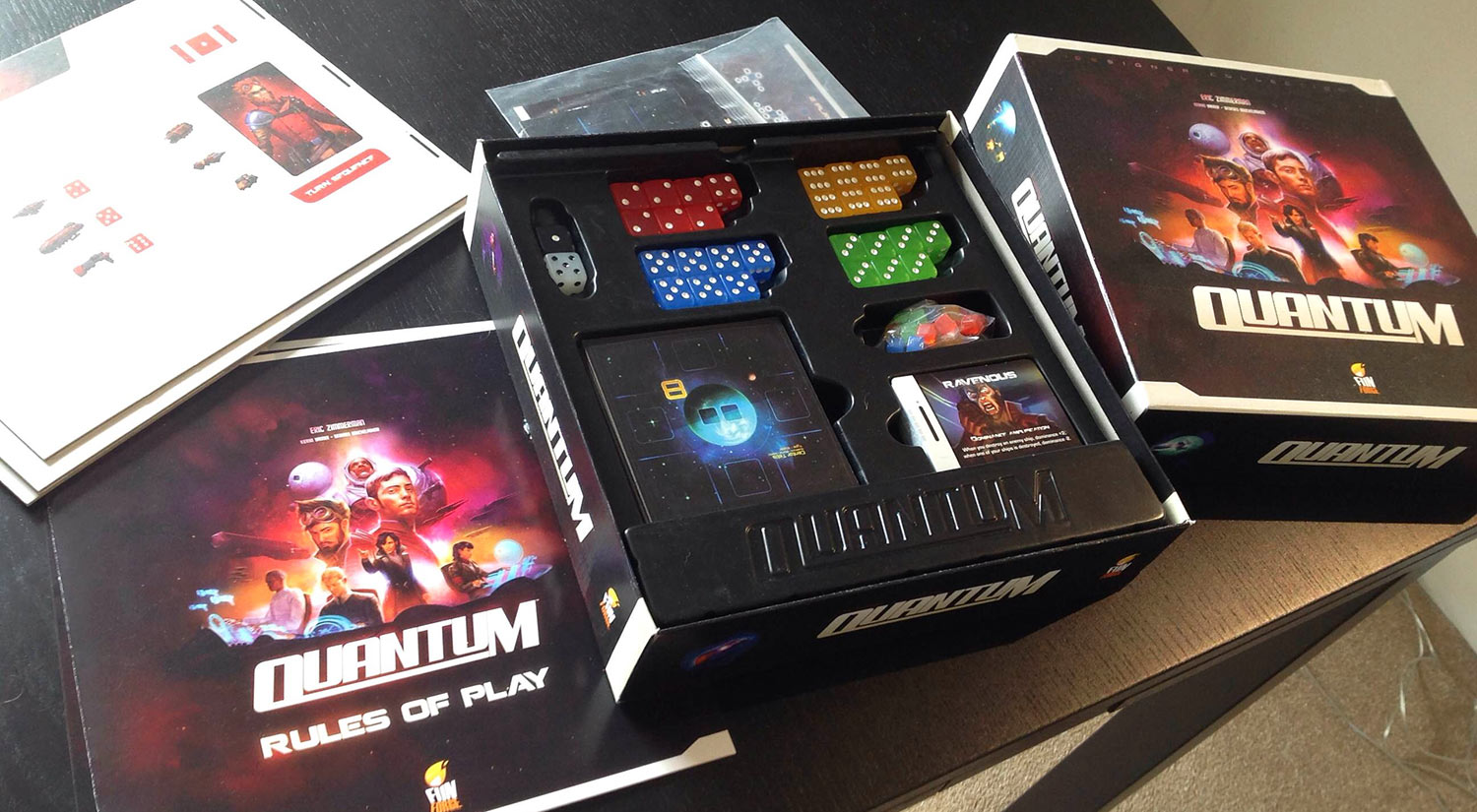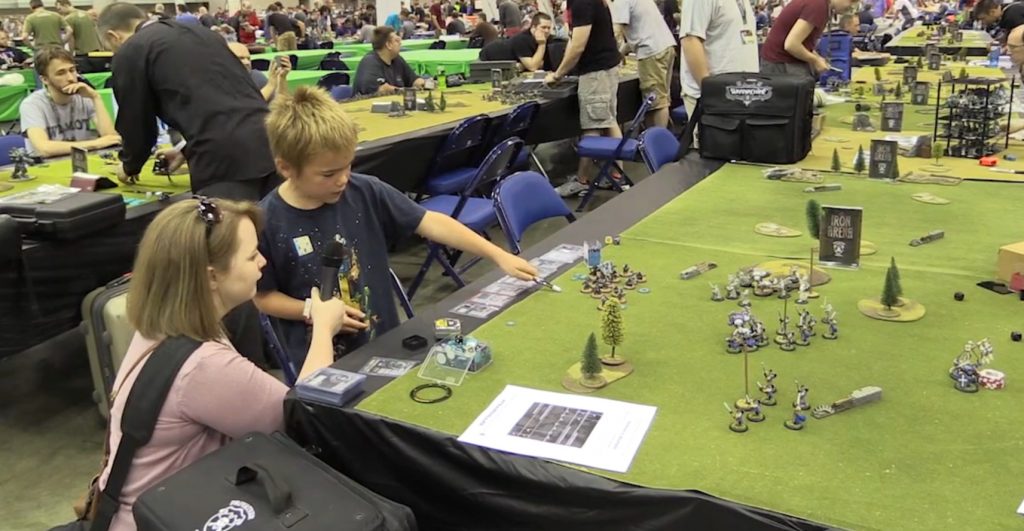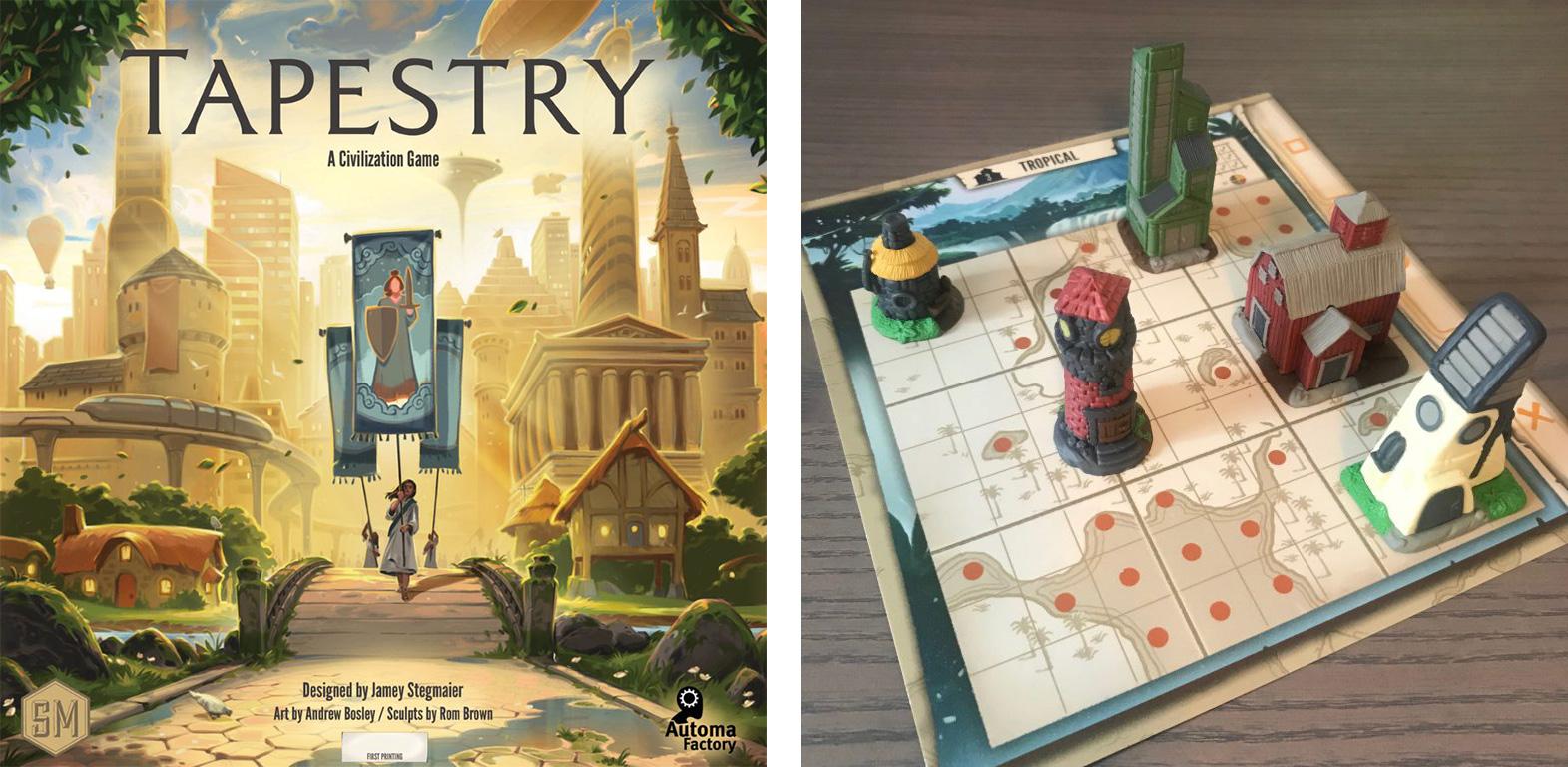[And now, a special treat for Simplicity Week. We’re very lucky today to be joined by Eric Zimmerman, games academic and designer of Quantum, a great new release that simplifies the space warfare genre into a few riotous handfuls of candy-coloured dice. In the first of a series of new developer post-mortems, we talked to Eric about exactly how simple the process was.]
Quinns: So, Quantum’s out, but board games don’t enjoy the immediacy of communication and online play you’d get with the video games you worked on before. How does it feel knowing this labour of love is being purchased and played in secret, the world over? HI, by the way.
Zimmerman: Glad to be here!
It’s true that when you are developing a board game, you’re able to personally keep track of all of the playtesting – either you are doing it yourself, or you are watching playtesters, or remote groups are playing your game and reporting to you afterwards. It’s a very different thing when people are playing your game and you’re not there.
Yesterday someone told me that the previous night she had played a three-hour game of Quantum. It was one of the really small four-player maps that forces everyone into constant, cutthroat combat. Most games of Quantum last less than an hour, so this must have been some kind of slugfest! I was in the middle of apologizing, when she interrupted me to tell me what a great time everyone had. These were experienced Quantum players, and they loved the fact that they had discovered an entirely new kind of game experience inside the same game box.
The sweetest pleasure for me of being a game designer is seeing players play your game in ways that you never anticipated. I’m already seeing lots of variations crop up… new map designs, 5 and 6-player variants, and even a version that removes all dice rolling. Quantum is meant to feel like a modular, reconfigurable system, so I am so glad to see some players taking it apart and making something new with it.
Quinns: Quantum’s received tremendous acclaim, not least from us. What are you most disappointed by in the finished design?
Zimmerman: That sounds like a trick question…
Quinns: Ahh, I’ve been rumbled.
Zimmerman: Honestly, I am really happy with the way that Quantum turned out – from the art direction that Philippe Nouhra spearheaded at FunForge to the quality of the materials to the wide distribution that it’s getting.
I don’t think there is any one big thing that disappoints me – it’s more like death by a thousand paper cuts. I wish that one or two of the ship powers weren’t quite so fussy; there are new post-launch questions coming up that I wish were included in the rules FAQ; text on a couple of the cards could use some editing. All of that is on me!
I’m like the filmmaker who can’t view his completed movie, because all he can see are the little glitches in cinematography, editing, lighting, etc. I suffer from that kind of neurosis about wanting to keep on polishing my game.
Quinns: So what board games are you playing and enjoying at the minute?
Zimmerman: It’s hard to keep up! A few days ago, I played Forbidden Desert and Power Grid for the first time at a friend’s house. (Shameful that I hadn’t played them before!) Fridays at the NYU Game Center we host “The Local Meta” – a weekly meeting of Netrunner players – and I’m just starting to scratch the surface on that one. Next on the docket for me is Space Cadets: Dice Duel. I go through phases of being deeply into a particular game or two – right now I’m in more of a grazing mode, sampling titles I’ve been wanting to play for a while. I still have a pile of games I picked up at Essen that I need to crack!
Quinns: What did you make of Power Grid? We find it’s pretty divisive over here. It’s beautiful, but so cruel. Like a rusty climbing frame.
Zimmerman: There’s a lot to like about Power Grid. For example, the way that the system gives players in last place a whole slew of first-mover advantages is an elegant way to keep things close. (Our game was a real nail-biter!) The wheels-within-wheels of factory bidding wars, the scarce resource economy, strategically powering your factories, competing for board space, etc. all adds up to a nice depth of head-spinning detail. My main criticisms for the game are fairly superficial: our English rules could have used some editing, and I wish the gorgeous Chris Ware-ish illustrations on the box cover and cards had made it to the map design. I liked the game design. But perhaps I like getting rust on my fingers.
Quinns: The big question, then. What attracted you to move from digital games to an analog format?
Zimmerman: For me a game is a game is a game. Of course, videogames, tabletop games, and other game formats (like the large-scale game installations I create with architect Nathalie Pozzi) have their unique advantages and limitations. But my own approach to game design is that the core elements of a game – what makes a choice meaningful for a player, for example – doesn’t vary that much whether you are on or off a computer.
I grew up playing tabletop games in the 1980s – from Risk to Ogre to the Tom Wham games published as inserts in Dragon Magazine. And I always enjoyed making boardgames, ever since I was very little. So although I’ve had a career as a videogame designer, in many ways I am returning to my roots with a game like Quantum. I should also mention that I’ve been making analog games for years, like The Metagame, the card game I created with Colleen Macklin and John Sharp at Local No. 12.
A board game like Quantum offers some amazing design challenges that don’t crop up as much in videogames. For example, because there is no software running “behind the scenes” to automate things in a tabletop game, players themselves are the CPU – they are the ones that run the software of the rules. This means that boardgames force a certain kind of game design elegance – you can’t just heap complexity into a turn phase sequence or combat system mechanic and expect players to lap it up. The streamlined design of Quantum is in many ways the result of me trying to come to grips with this issue of elegance in gameplay. It’s nice that your review (and others) have noticed it.
Quinns: About the CPU thing. The closer I look in board gaming, the more I find the designers whose work I love the most have backgrounds in mathematics, statistics, programming. Is this some reedy secret of board game design? The importance of a grasp of figures, the ability to iterate on and understand results of testing?
Zimmerman: Well… I don’t have a background in anything numerical (I was an art student). But I do think that game designers need to be able to think structurally, which is – I think – what you’re getting at. While all forms of culture are systems (a poem is a language system, a painting is a visual system), games are particularly structural. They are very much machines of parts that have dynamic, shifting relationships that change over time based on the decisions of players. (Think pieces on a Chess board, or players on a Football pitch or in a virtual play field.) A game is a system of parts in a very literal sense – a painting or poem doesn’t have the same degree of mechanistic complexity.
Math or statistics can be a great basis for this kind of structural literacy. But you need more. Systems fluency is necessary but not sufficient to be a game designer. You also need to understand how those systems become human experience – the aesthetic, narrative, emotional, psychological, social, and cultural aspects of the gameplay experience. This is part of why I like game design so much – it really fires up just about every corner of my brain.
Some game designers are natural storytellers. Others are hardcore analytic math nerds. Others have a great sense of what gives players pleasure. There isn’t one way to be a game designer, just like there isn’t one way for a game to be meaningful to its players.
Quinns: What were your perspectives on the board game industry before you began working in it? What are your views afterwards?
Zimmerman: The grass is always greener on the other side! In today’s world of digitally distributed videogames, I was really attracted to the idea of making a “beautiful object” – something that you could actually put on a shelf! This is actually one of the reasons I worked with FunForge – I think Tokaido is one of the most visually stunning boardgames I have ever seen. And they certainly delivered on the Quantum box and materials.
Of course, there are many, many, many limitations of working with atoms over bits! It takes a long time to get a physical game made. And it’s hard as hell to distribute them! And unfortunately, the laws of reality conspire against automatically distributing a patch that will magically appear in all of the boxes that have already been purchased by your players. So I had to unlearn some of the assumptions I inherited from being in videogames.
One of the things I love about the boardgames world is how passionate the players are about what they love – and what they hate – about games. It’s true in the videogame world as well, but there’s something more disposable about digital games. People take every tabletop game purchase really seriously and there’s an incredible level of literacy among players. I’ve been promoting Quantum at events like Essen and Boardgamegeek con and I’ve been consistently amazed at the connoisseurship of boardgame players – but also about how friendly and open they are about sharing their knowledge and diving into a game with complete strangers.
I’ve loved working in the boardgame world and I promise that Quantum will not be my last tabletop title!
Quinns: Thanks so much for your time.
[A quick Google indicates that Quantum is still readily available in North America, but stocks are rapidly drying up in Europe. If you’re interested, probably pick it up quick.]










